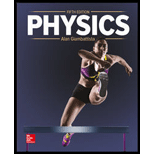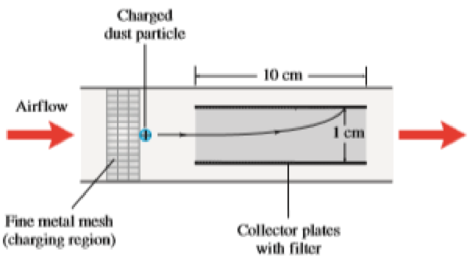
An air ionizer fillers particles of dust, pollen, and other allergens from the air using electric forces. In one type of ionizer (see diagram), a stream of air is drawn in with a speed of 3.0 m/s. The air passes through a fine, highly charged wire mesh that transfers electric charge to the particles. Then the air passes through parallel “collector” plates that admet the charged particles and trap them in a filter. Consider a dust particle of radius 6.0 μm, mass 2.0 × 10–13 kg, and charge l000e. The plates are 10 cm long and are separated by a distance of 10 cm. (a) Ignoring drag forces, what would be the minimum potential difference between the plates to ensure that the particle gets trapped by the filter? (b) At what speed would the particle be moving relative to the stream of air just before hitting the filter? (c) Calculate the viscous drag force on the particle when moving at the speed found in (b). (d) Is it realistic to ignore drag? Taking drag into consideration, is the minimum potential difference larger or smaller than the answer to (a)?

(a)
The minimum potential difference between the plates to ensure that the particle gets trapped by the filter.
Answer to Problem 125P
The minimum potential difference between the plates to ensure that the particle gets trapped by the filter is
Explanation of Solution
Write the equation for the time taken by the dust particle to pass through the length of the collector plates.
Here,
Write the equation of motion in vertical direction.
Here,
The initial speed of the particle in the vertical direction is zero.
Substitute
Put equation (I) in equation (II).
Write the equation for the net force on the particle in the vertical direction.
Here,
Rewrite the above equation for
The net force in the vertical direction is equal to the electric force.
Write the relationship between the net force and the electric force.
Here,
Put the above equation in equation (IV).
Write the equation for the electric force.
Here,
Write the equation for the electric field.
Here,
Put the above equation in equation (VI).
Put equation (VII) in equation (V).
Equate equations (III) and (VIII) and rewrite it for
Substitute
Here,
Conclusion:
The value of
Substitute
Therefore, the minimum potential difference between the plates to ensure that the particle gets trapped by the filter is
(b)
The speed at which the particle would be moving relative to the stream of air just before hitting the filter.
Answer to Problem 125P
The speed at which the particle would be moving relative to the stream of air just before hitting the filter is
Explanation of Solution
Write the equation of motion in vertical direction.
Here,
Substitute
Put equation (II) in the above equation.
Put equation (I) in the above equation.
Conclusion:
Substitute
Therefore, the speed at which the particle would be moving relative to the stream of air just before hitting the filter is
(c)
The viscous drag force on the particle when moving at the speed found in part (b).
Answer to Problem 125P
The viscous drag force on the particle when moving at the speed found in part (b) is
Explanation of Solution
Write the equation for the drag force.
Here,
Conclusion:
The viscosity of air is
Substitute
Therefore, the viscous drag force on the particle when moving at the speed found in part (b) is
(d)
Whether it is realistic to ignore the drag and whether the minimum potential difference larger or smaller than the answer to part (a) when drag is considered.
Answer to Problem 125P
It is not realistic to ignore the drag and the minimum potential difference should be larger when drag is considered.
Explanation of Solution
It is realistic to ignore the drag if the drag force is much smaller than the electric force.
Substitute
Conclusion:
Substitute
The value of
Therefore, it is not realistic to ignore the drag and the minimum potential difference should be larger when drag is considered.
Want to see more full solutions like this?
Chapter 17 Solutions
Physics
- An eccentric inventor attempts to levitate by first placing a large negative charge on himself and then putting a large positive charge on the ceiling of his workshop. Instead, while attempting to place a large negative charge on himself, his clothes fly off. Explain.arrow_forwardA person is placed in a large, hollow, metallic sphere that is insulated from ground, (a) If a large charge is placed on the sphere, will the person be harmed upon touching the inside of the sphere? (b) Explain what will happen if the person also has an initial charge whose sign is opposite that of the charge on the sphere.arrow_forwardUnreasonable results A wrecking yard inventor wants to pick up cars by charging a 0.400 m diameter ball and inducing an equal and opposite charge on the car. If a car has a 1000 kg mass and the ball is to be able to lift it from a distance of 1.00 m: (a) What minimum charge must be used? (b) What is the electric field near the surface of the ball? (c) Why are these results unreasonable? (d) Which premise or assumption is responsible?arrow_forward
- To form a helium atom, an alpha particle that contains two protons and two neutrons is fixed at one location, and two electrons are brought in from far away, one at a time. The first electron is placed at 0.6001010 m from the alpha particle and held there while the second electron is brought to 0.6001010 m from the alpha particle on the other side from the first electron. See die final configuration below, (a) How much work is done in each step? (b) What is the electrostatic energy of die alpha particle and two electrons in the final configuration?arrow_forwardIn different experimental trials, an electron, a proton, or a doubly charged oxygen atom (O--), is fired within a vacuum tube. The particle's trajectory carries it through a point where the electric potential is 40.0 V and then through a point at a different potential. Rank each of the following cases according to the change in kinetic energy of the particle over this part of its flight from the largest increase to the largest decrease in kinetic energy. In your ranking, display any cases of equality, (a) An electron moves from 40.0 V to 60.0 V. (b) An electron moves front 40.0 V to 20.0 V. (c) A proton moves from 40.0 V to 20.0 V'. (d) A proton moves from 40.0 V to 10.0 V. (e) An O-- ion mines from 40.0 V to 60.0 V.arrow_forwardReview. From a large distance away, a particle of mass m1, and positive charge q1 is fired at speed in the positive x direction straight toward a second particle, originally stationary but free to move, with mass m2, and positive charge q2. Both particles are constrained to move only along the x axis. (a) At the instant of closest approach, both particles will be moving at the same velocity. Find this velocity, (b) Find the distance of closest approach. After the interaction, the particles will move far apart again. At this time, find the velocity of (c) the particle of mass m1, and (d) the particle of mass m2.arrow_forward
- (a) Two protons in a molecule are 3.80 10-10 m apart. Find the magnitude of the electric force exerted by one proton on the other. (b) State how the magnitude of this force compares with the magnitude of the gravitational force exerted by one proton on the other. (c) What If? What must be a particles charge-to-mass ratio if the magnitude of the gravitational force between two of these particles is equal to the magnitude of electric force between them?arrow_forwardReview. A light, unstressed spring has length d. Two identical particles, each with charge q, are connected to the opposite ends of the spring. The particles are held stationary a distance d apart and then released at the same moment. The system then oscillates on a frictionless, horizontal table. The spring has a bit of internal kinetic friction, so the oscillation is damped. The particles eventually stop vibrating when the distance between them is 3d. Assume the system of the spring and two charged particles is isolated. Find the increase in internal energy that appears in the spring during the oscillations.arrow_forwardTwo point charges attract each other with an electric force of magnitude F. If the charge on one of the particles is reduced to one-third its original value and the distance between the particles is doubled, what is the resulting magnitude of the electric force between them? (a) 112F (b) 13F (c) 16F (d) 34F (e) 32Farrow_forward
- Find to three significant digits the charge and the mass of the following particles. Suggestion: Begin by looking up the mass of a neutral atom on the periodic table of the elements in Appendix C. (a) an ionized hydrogen atom, represented as H+ (b) a singly ionized sodium atom, Na+ (c) a chloride ion Cl (d) a doubly ionized calcium atom, Ca++ = Ca2+ (e) the center of an ammonia molecule, modeled as an N3 ion (f) quadruply ionized nitrogen atoms, N4+, found in plasma in a hot star (g) the nucleus of a nitrogen atom (h) the molecular ion H2Oarrow_forwardIntegrated Concepts A lightning bolt strikes a tree, moving 20.0 C of charge through a potential difference of 1.00102 MV. (a) What energy was dissipated? (b) What mass of water could be raised from 15°C to the boiling point and then boiled by this energy? (c) Discuss the damage that could be caused to the tree by the expansion of the boiling steam.arrow_forwardUsing Figure 18.43, explain, in terms of Coulomb's law, why a polar molecule (such as in Figure 18.43) is attracted by both positive and negative charges Figure 18.43 Schematic representation of the outer electron cloud of a neutral water molecule. The electrons spend more time near the oxygen than the hydrogens, giving a permanent charge separation as shown. Water is thus a polar molecule. It is more easily affected by electrostatic forces thanarrow_forward
 Physics for Scientists and Engineers, Technology ...PhysicsISBN:9781305116399Author:Raymond A. Serway, John W. JewettPublisher:Cengage Learning
Physics for Scientists and Engineers, Technology ...PhysicsISBN:9781305116399Author:Raymond A. Serway, John W. JewettPublisher:Cengage Learning Principles of Physics: A Calculus-Based TextPhysicsISBN:9781133104261Author:Raymond A. Serway, John W. JewettPublisher:Cengage Learning
Principles of Physics: A Calculus-Based TextPhysicsISBN:9781133104261Author:Raymond A. Serway, John W. JewettPublisher:Cengage Learning Physics for Scientists and EngineersPhysicsISBN:9781337553278Author:Raymond A. Serway, John W. JewettPublisher:Cengage Learning
Physics for Scientists and EngineersPhysicsISBN:9781337553278Author:Raymond A. Serway, John W. JewettPublisher:Cengage Learning Physics for Scientists and Engineers with Modern ...PhysicsISBN:9781337553292Author:Raymond A. Serway, John W. JewettPublisher:Cengage Learning
Physics for Scientists and Engineers with Modern ...PhysicsISBN:9781337553292Author:Raymond A. Serway, John W. JewettPublisher:Cengage Learning
 College PhysicsPhysicsISBN:9781938168000Author:Paul Peter Urone, Roger HinrichsPublisher:OpenStax College
College PhysicsPhysicsISBN:9781938168000Author:Paul Peter Urone, Roger HinrichsPublisher:OpenStax College





